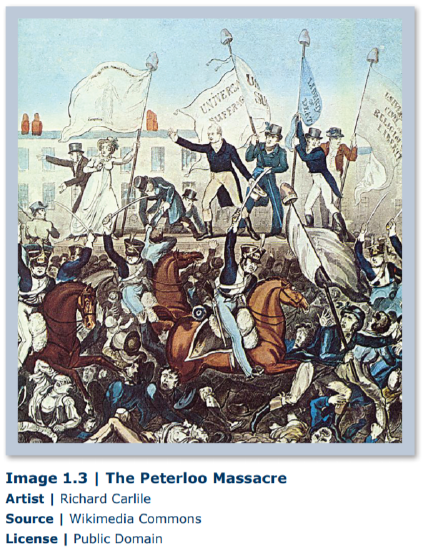The Romantic era was characterized by revolutions, including the American, the French, and the Industrial. The American Revolution had an impact on all of Europe. Its causes included the desire for political freedom and economic stability that the colonialists saw King Georgia III as menacing. England saw the American colonies as a source of materials and goods not in England proper and as a market for goods produced by England. Much against which the colonists objected were British laws endeavoring to maintain this economic balance. When England forcefully repressed protests and rebellion, the colonies directed their ire against King George III in their Declaration of Independence. And in the Declaration, individual freedom and independence were added to economic freedom as social and moral claims.
In addition to the American Revolution, England experienced its own economic revolution—commercial, agricultural, in transportation with new roads and canals, in industrialization. The Industrial Revolution became visible to many people about the mid-1700s. It was a revolution in methods, organization, and economic principles. Before industrialization, England functioned by a Medieval code of minute regulations in business and trade and restrictions on mobility and labor.
Comparatively few people in England at that time had actual, independent rights, particularly of possession. People who had lived on the land for centuries were tenants, not owners. With progress in manufacture, particularly in textiles, came the Enclosure movement, that is, the enclosing of land which previously had been available to everyone. Landowners threw out their tenants and enclosed their land for raising sheep because wool was a profitable commodity. Agriculture consequently declined and tenants moved to cities to work in new factories and mills.
 The shift in employment opportunities—or lack thereof—through increasing mechanization resulted in riots such as The Peterloo Massacre. Percy Bysshe Shelley (1792-1822) responded with poems like “England in 1819” that supported the working class. While working men suffered, women also faced restrictions, as they had almost no legal rights and few, if any, educational opportunities.
The shift in employment opportunities—or lack thereof—through increasing mechanization resulted in riots such as The Peterloo Massacre. Percy Bysshe Shelley (1792-1822) responded with poems like “England in 1819” that supported the working class. While working men suffered, women also faced restrictions, as they had almost no legal rights and few, if any, educational opportunities.
The French Revolution evoked the American Revolution and England’s Glorious Revolution during which Charles I was beheaded. The French Revolution smashed institutions, destroyed the monarchy and aristocracy, and built a new (though not permanent) order. An ideal of the French Revolution was to let the individual freely develop, so it opposed the institutions that checked individual rights.
Nations such as Austria and Prussia allied against the revolution and were defeated by the Revolutionary Army that spread over Italy and Germany. Under the impact of war, counter-revolutions sprung up, and the Committee of Public Safety (1793) was formed. Through its Reign of Terror (1793-94), the Committee suppressed revolt and counter-revolution. 20,000 heads were struck off by the guillotine. The bicameral legislative government, called the Directory (1795), came into power but fell to a coup d’etat (1799) run by its own general, Napoleon Bonaparte (1769-1821).
The early Romantic writers at first greatly sympathized with the French Revolution. They were convinced that a revolution for moral change would occur in England. It seemed to them that the new millennium had arrived. William Blake saw it as the creation of a new world and himself as its prophet. Coleridge and Wordsworth responded with peons of joy, declaring, “bliss was it in that dawn to be alive” (Wordsworth The Prelude). Both went to France and even fell in love with French women. They returned chastened by the Reign of Terror. Edmund Burke’s Reflections on the French Revolution condemned the Revolution as an attempt to methodize anarchy. Reaction in England soon set in. English freedom became increasingly restricted through such acts as the Proclamation Against Seditious Writing. Parliament suspended habeas corpus, making possible imprisonment without trial, and passed the Treasonable and Seditious Practices Act (1795). Reaction against reform was stiffened by the ensuing Napoleonic Wars.


 The shift in employment opportunities—or lack thereof—through increasing mechanization resulted in riots such as The Peterloo Massacre. Percy Bysshe Shelley (1792-1822) responded with poems like “England in 1819” that supported the working class. While working men suffered, women also faced restrictions, as they had almost no legal rights and few, if any, educational opportunities.
The shift in employment opportunities—or lack thereof—through increasing mechanization resulted in riots such as The Peterloo Massacre. Percy Bysshe Shelley (1792-1822) responded with poems like “England in 1819” that supported the working class. While working men suffered, women also faced restrictions, as they had almost no legal rights and few, if any, educational opportunities.